If you haven’t bought any new appliances recently you may not know that the energy rating scale has changed. But if you have and didn’t really notice, that’s probably because it hasn’t changed by much. It still uses the graduated traffic light colour system; but the lettering scale has changed. This took effect in the UK March 2021. In this article we will talk you through all you need to know about the new energy ratings label.
What is the new energy ratings label?
The energy rating label for some appliances has changed. From March 2021 a new energy rating scale has been put in place to make it easier to distinguish between energy efficient appliances. When purchasing a new appliance, customers will be able to make a more informed decision and find it similar to compare products.
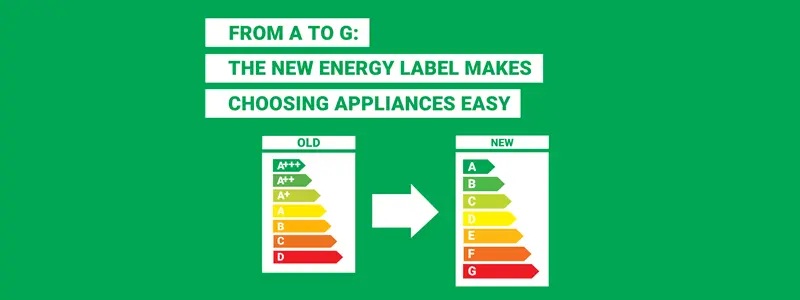
What are the new energy ratings?
The new energy ratings now rage from A to G. The new scale looks the same and still uses the identical coloured tier system. The removal of the + sign from the old A+++ to D scale will make it much clearer to identify the most efficient product to purchase. This new energy rating scale has been incorporated into a reworked energy label. The label as a whole with all of its changes and new additions has become a beneficial tool when making an appliance purchase. More information on the new label changes can be found in this article.
Appliances included in the new energy ratings label:
- Refrigerator
- Freezer
- Wine cooler
- Washing machine
- Washer dryer
- Dish washer
- TVs and displays
Appliances not using the new rating label
Not all appliances use the new energy rating scale. This includes Tumble dryers, range hoods and ovens. This will no doubt come in the future; but a date has not yet been set.
Can you compare the old to the new energy ratings label? You cannot directly compare the old label with the new. The change is not as simple as the old letters being shifted down the scale. Some testing methods to determine the efficiency of products have changed. With different calculations being used different results will be produced, meaning a direct correlation will not be possible.
What is the new A+++ energy rating?
The previous highest rating on the old scale was A+++. This was given to appliances with the highest rating in its class at the time. Although a direct comparison between the old and new energy scales can’t me make; a very rough guide can be followed. If your current appliance was rated A+++; on the new scale it could be compared at level B or lower. This correlation can then be cautiously allied to the other letters.
Why did the energy rating scale change?
First introduced over 25 years ago; the energy ratings scale was due an update. Its initial use case has become outdated due to ever increasing appliance efficiency. The old scale’s range was unable to keep up with innovation. The majority of products resided in the top tiers of the scale which all consisted of A’s just with additional + signs.
Of people surveyed, many found the system confusing. Not being able to determine much difference between all the A level products. Meaning, they though as long as the appliance had an A rating it would be good regardless the amount of +’s after it. This would result in consumers purchasing lower efficiency appliances and manufacturers not striving to create better products.
The new scale gets rid of all the + signs in favour of a simple A to G system. Staying very similar to the old style you may not notice much difference. Other than it will look like appliances have all of a sudden got very inefficient, as we are used to seeing mostly A rated products.
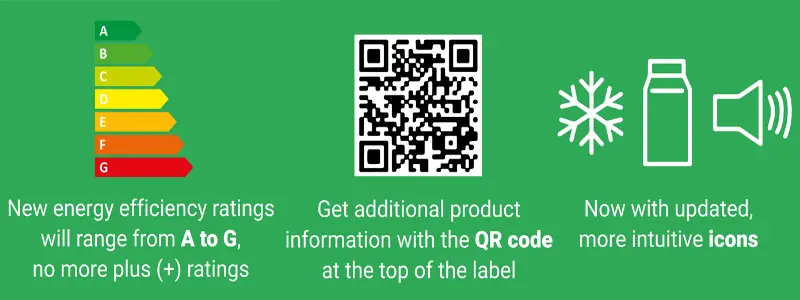
New features on the energy ratings label
The new label features the updated energy scale, a QR code and additional intuitive icons (depending on the product type). The new QR code feature can be found in the top right of the label. Using a smart phone you can scan the code to gain access to more in depth detail about that specific product. This will be great for in store purchases; as often not all specs are shown on the products displayed.
There are also plenty of new icons accompanying the rating to help inform decisions on the efficiency of a product.
An array of new icons can now be found on the new label. Some of these include ratings for noise levels, water consumption and capacity. These icons will give a better understanding of a products workings and easily comparable features. Icons on the new energy ratings label:
- Capacity – Amount the appliance can hold. Refrigerators are measured in litres (L). Fridge and freezer sections indicated separately. Wine coolers indicate the number of bottles held. Washing machines are measured in kilograms (kg). Dishwashers indicate the number of place settings which can be held. A place setting is classed as 1x dinner plate, dessert plate, soup bowl, glass, cup, saucer and cutlery.
- Water consumption – The amount of water used on the eco mode program, measured in litres.
- Spin drying – Efficiency rated A-G.
- Duration – Time taken to complete a cycle on the eco setting, measured in hours and minuets.
- Airborne acoustical noise emissions – Noise emitted in decibels (dB) rated on an A-D scale.
- HDR mode – energy used per 1000 hours in kWh in high dynamic range (HDR) mode.
- Resolution and screen size – Measured in pixels and cm/inches diagonally.
How to recognise an efficient appliance?
The efficiency of products can vary. This is prominent when it comes to different product categories. Some sections of the market produce vastly more efficient products than others. For things like TVs and monitors the current highest rating on the market is a D. However there are already some washing machines and fridge freezers available to purchase that of A rating. This is important to know when shopping around for the most efficient appliance as it helps us understand the levels that are currently reached. The diagram below shows the current highest ratings achieved in each product category. This includes appliances using the new energy rating scale and ones that still adhere to the old scale.
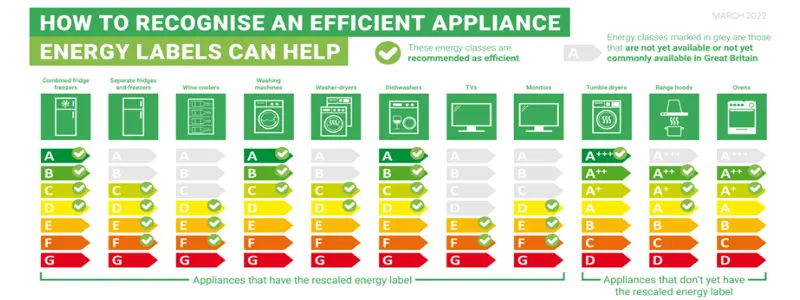
What are the new energy ratings labels?
When looking at the new energy ratings label, you will notice some elements change according to the appliance category. The rating scale, QR code and kWh number will always be present on the new label. The union jack can also be found in the top corner; showing the product was produced for the UK market.
The bottom section of the label is where you’ll find the additional new icons; the information given here will depend on the appliance. The energy consumption, shown in kWh (kilowatt hours) will also depend on the appliance. There are three variations of how this is displayed:
- kWh/100 cycles - This is the amount of energy used per 100 cycles, usually measured on the eco setting of the appliance. This is for items with a specific run time, like washing machines and dishwashers.
- kWh/1000h - Energy used per 1000 hours the appliance is used. TVs, displays and light sources are measured in this way.
- kWh/annum - The amount of energy used per year. This is for appliances that are kept running 24/7, such as fridges and freezers.
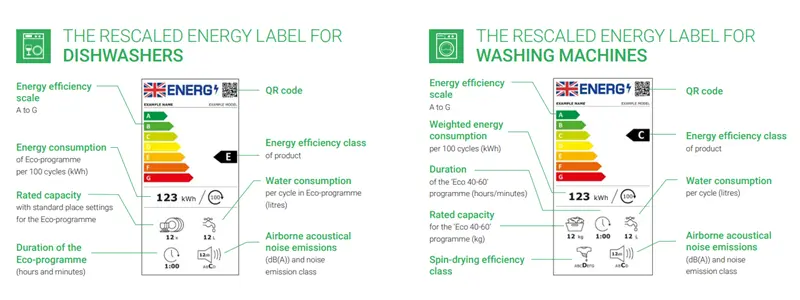
New energy label for dishwashers and washing machines
Tips
- When looking to purchase a wet appliance, choose a size best suited to your home’s needs. Don’t opt for something too big that you won’t be able to fully fill each time you use it. Similarly don’t go for something that’s too small that will mean doing multiple loads.
- Get a dishwasher with an eco-mode to reduce energy consumption.

New energy label for refrigerators and freezers
Tips
- Choosing a cold appliance with a digital thermostat will help keep it regulated. Fridges should be kept around 5 degrees and freezers -18. For each degree the appliance is lowered there is an increase in energy consumption.
- Auto defrost on a freezer is often a high energy consuming feature. Try choosing one without this feature.
- Consider where the appliance will be placed. You may want something with a lower noise rating.
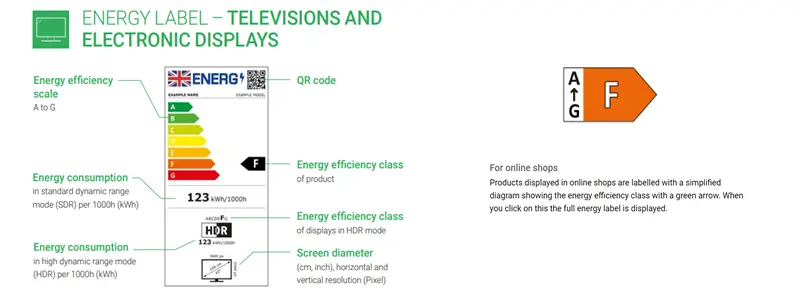
New energy label for televisions and electronic displays
Tips
- Consider the screen size; larger screens have higher energy consumption.
- Brightness and resolution can also affect consumption. Some models have auto functions for this. But by lowering both your display will use less energy.
- Most TVs now come with a power saving mode. Usually your TV will come with mode on; but do check as it will help reduce energy consumption.
Online energy ratings label
When shopping for an appliance online that adheres to the new energy rating label; you will see a more simplified version of the rating scale. A letter within a coloured arrow will indicate the appliances energy rating. When clicked on the full energy label will be displayed.
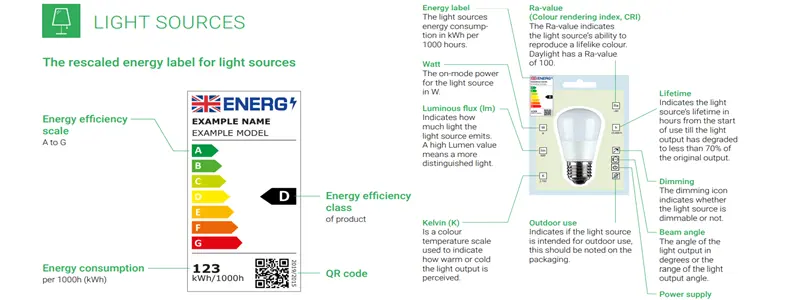
New energy label for light sources
The scale for light sources has also changed. This was more recently introduced in October 2021. We are currently within an 18 months transition period; where you could find products that show the old and new energy ratings labels. This transition period will end on 31 March 2023; after which producers and seller will no longer be able to display the old energy rating scale. There has been a major crack down worldwide on the use of inefficient lighting. You can read more about bulbs that are affected in our Light Bulb Ban article. You will find a plethora of icons shown on light bulb packaging, including the new energy rating label. The picture above shows the different indicators that can be found and what they mean.
Ultimately this is a step in the right direction. Consumers will be able to make more informed decisions and clearer choices when picking energy efficient products. And manufacturers are now back in a race to be the best and produce the newest most efficient appliance.
Will this new system last?... Only time will tell. But a governing body has been put in place to keep an eye on its progress and make any changes for the future.










